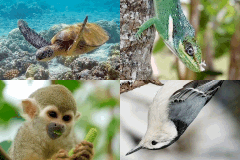AnAge entry for Loxodonta africana
Classification (HAGRID: 02474)
- Taxonomy
-
Kingdom: Animalia
Phylum: Chordata
Class: Mammalia (Taxon entry)
Order: Proboscidea
Family: Elephantidae
Genus: Loxodonta
- Species
- Loxodonta africana
- Common name
- African bush elephant
Lifespan, ageing, and relevant traits
- IMR
- 0.002/year
- MRDT
- 8 years
- Maximum longevity
- 65 years (captivity)
- Source
- ref. 671
- Sample size
- Large
- Data quality
- Acceptable
- Observations
Under optimal conditions, males attain sexually maturity at about 10 years of age and females at 11 years of age. Some animals, however, may not reach sexual maturity until they are 20 years old, and males generally do not reproduce until they are over 20 years of age. Elephants are long-lived mammals, but probably not as long-lived as often cited. Females remain fertile for about 55-60 years and elephants have been estimated to live up to 70 years in the wild [0434]. More conservative estimates suggest elephants live up to 65 years in the wild [0536]. In captivity, there are anecdotal reports of animals living over 80 years. Record longevity, however, belongs to one wild born female that was still living at 53-54 years of age [0671]. Despite having as much as six sets of molars in a lifetime, elephants suffer from teeth erosion as a type of mechanical senescence.
Life history traits (averages)
- No information is available on life history. Please contact us if you wish to suggest or contribute data.
Metabolism
- Typical body temperature
- 309ºK or 36.2ºC or 97.2ºF
- Basal metabolic rate
- Not yet available
References
- [1240] Lee et al. (2016), The reproductive advantages of a long life: longevity and senescence in wild female African elephants (PubMed)
- [1222] Abegglen et al. (2015), Potential Mechanisms for Cancer Resistance in Elephants and Comparative Cellular Response to DNA Damage in Humans (PubMed)
- [1143] Nussey et al. (2013), Senescence in natural populations of animals: widespread evidence and its implications for bio-gerontology (PubMed)
- [1080] Lee et al. (2012), African elephant age determination from teeth: validation from known individuals
- [1136] Gomes et al. (2011), Comparative biology of mammalian telomeres: hypotheses on ancestral states and the roles of telomeres in longevity determination (PubMed)
- [1097] Clubb et al. (2008), Compromised survivorship in zoo elephants (PubMed)
- [1025] Kinahan et al. (2007), Body temperature daily rhythm adaptations in African savanna elephants (Loxodonta africana) (PubMed)
- [0671] Richard Weigl (2005), Longevity of Mammals in Captivity; from the Living Collections of the World
- [0536] Wiese and Willis (2004), Calculation of longevity and life expectancy in captive elephants
- [0610] Ernest (2003), Life history characteristics of placental non-volant mammals
- [0434] Ronald Nowak (1999), Walker's Mammals of the World
- [0676] Purvis and Harvey (1995), Mammal life-history evolution: a comparative test of Charnov's model
- [1081] Lee and Moss (1995), Statural growth in known-age African elephants (Loxodonta africana)
- [0677] Saether and Gordon (1994), The adaptive significance of reproductive strategies in ungulates (PubMed)
- [0455] Virginia Hayssen et al. (1993), Asdell's Patterns of Mammalian Reproduction: A Compendium of Species-Specific Data
- [0002] Caleb Finch (1990), Longevity, Senescence, and the Genome
- [0680] Wootton (1987), The effects of body mass, phylogeny, habitat, and trophic level on mammalian age at first reproduction
- [0731] Zullinger et al. (1984), Fitting sigmoid equations to mammalian growth curves
External Resources
- Integrated Taxonomic Information System
- ITIS 584939
- Animal Diversity Web
- ADW account
- Encyclopaedia of Life
- Search EOL
- NCBI Taxonomy
- Taxonomy ID 9785
- Entrez
- Search all databases
- Ageing Literature
- Search Google Scholar or Search PubMed
- Images
- Google Image search
- Internet
- Search Google

